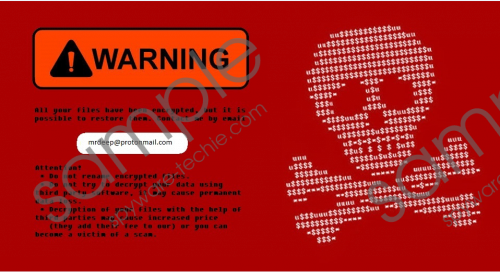Do you know what Scarab-Deep Ransomware is?
Scarab-Deep Ransomware belongs to Scarab Ransomware family as it is incredibly similar to other malicious applications from this group and especially to Scarab-Bomber Ransomware. Our computer security specialists say this variant is extremely dangerous because besides encrypting user’s files; it was noticed the malware could infect the system with banking Trojans. Consequently, users who encounter it might not only lose their private data but also end up being scammed by hackers who could get their hands on the victims’ sensitive information. Therefore, we recommend erasing Scarab-Deep Ransomware as soon as possible. Even though it will not restore any files that were encrypted, deleting the malware may help you clean the system and it is the best option for those who do not want to pay a ransom. The removal guide available below will show how to deal with the malicious application manually. However, to ensure it is completely gone and erase the threats it might have placed on the computer; it would be smart to scan the computer with a reputable antimalware tool too.
The malicious application could be spread through infected email attachments, unsecured RDP connections, harmful file-sharing web pages, and so on. One way of the other, if Scarab-Deep Ransomware infects the system, it should create a temporary copy of its launcher in the %APPDATA% directory. Next, the malware is supposed to drop a couple of copies of a banking Trojan known as ClipBanker. The mentioned Trojan copies should be placed in the %TEMP% and %APPDATA%\Microsoft\Windows directories. Once these files are created and the infection settles in it should start encrypting user’s data with a robust encryption algorithm. Scarab-Deep Ransomware screenshot
Scarab-Deep Ransomware screenshot
Scroll down for full removal instructions
It seems the threat targets user’s personal files, such as photos, videos, text or other documents, and so on. To mark its encrypted files, Scarab-Deep Ransomware might place the .deep extension at the end of their titles, for example, a picture named starts.jpg would turn into stars.jpg.deep. After the changes are made, it should be impossible to open the affected data as the computer is supposed to say it cannot be recognized. It is when, the malware should create text documents containing ransom notes, for example, HOW TO RECOVER ENCRYPTED FILES.TXT. According to these documents, victims who wish to decrypt their files should contact the hackers behind Scarab-Deep Ransomware to receive instructions on how to pay the ransom. Needless to say, whatever they may promise, these people cannot be trusted, and there is always a possibility you could get scammed. Because of this, we recommend not to take any chances and erase the threat and the Trojans it could place on the computer right away.
Users who decide they do not want to pay the ransom or keep this infection on their system any longer could use the removal guide located a bit below. The provided steps will explain how to get rid of files created by the malicious application. We cannot guarantee completing these steps will help you eliminate Scarab-Deep Ransomware and the Trojans that may come with it entirely, which is why it might be best to leave this task to a reliable antimalware tool of your choice.
Erase Scarab-Deep Ransomware
- Press Ctrl+Alt+Delete.
- Go to the Task Manager.
- Find the malware’s process.
- Mark this process and click End Task.
- Exit Task Manager.
- Tap Win+E.
- Navigate to:
%TEMP%
%USERPROFILE%\desktop
%USERPROFILE%\downloads - See if you can locate an executable file launched before the computer got infected.
- Right-click the malicious file and press Delete.
- Then check the %TEMP% and %APPDATA%\Microsoft\Windows directories.
- Look for suspicious executable files, for example, updlive.exe or {random name}.exe; right-click them and select Delete.
- Delete the threat’s created text documents called HOW TO RECOVER ENCRYPTED FILES.TXT or similarly (one of it should be in the %USERPROFILE% directory).
- Close File Explorer.
- Press Windows Key+R.
- Navigate to HKU\S-1-5-21-563032844-4108150345-4119072607-1000\Software\Microsoft\Windows\CurrentVersion\Run
- Look for a value name with a random name and pointing to C:\Users\user\HOW TO RECOVER ENCRYPTED FILES.TXT
- Right-click this value name and select Delete.
- Close Registry Editor.
- Empty Recycle bin.
- Reboot the system.
In non-techie terms:
Scarab-Deep Ransomware is a malicious program that should encrypt user’s private files and then display a ransom note claiming the files were locked “due to a security problem with your PC.” There might be some truth in it since if your computer was secure and you did not act carelessly, you may have avoided this infection. Nonetheless, if it managed to settle in, we would advise you not to make any rash decisions as it could lead to making more mistakes. For instance, paying the ransom might look like an easy solution, but it is vital to understand there are no guarantees the malware’s developers will hold on to their promises and allow you to restore encrypted files. Thus, our computer security specialists advise not to trust the malicious application’s developers and eliminate it as soon as possible. For manual deletion instructions, you could take a look at the removal guide available a bit above or you get rid of the threat with a reputable antimalware tool of your choice.
